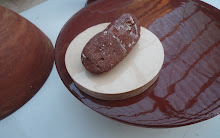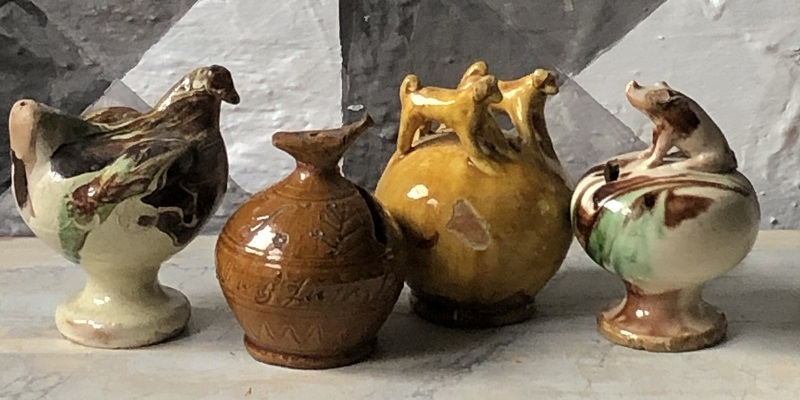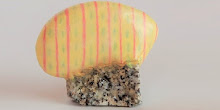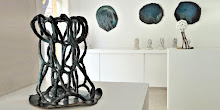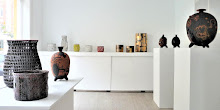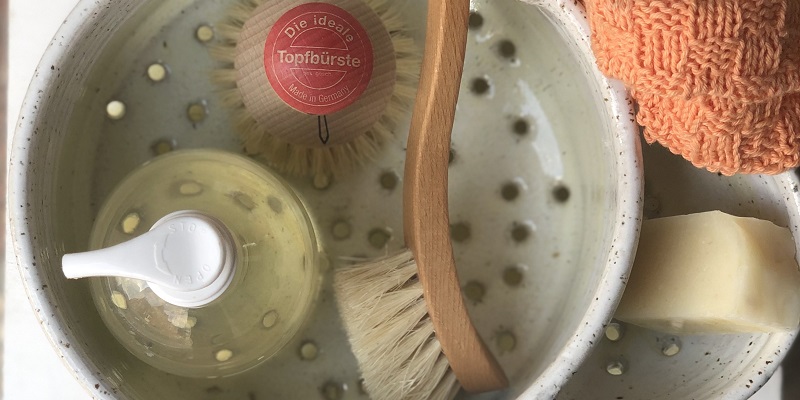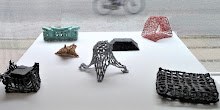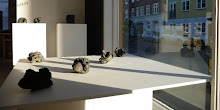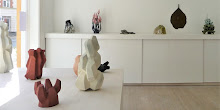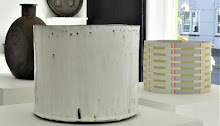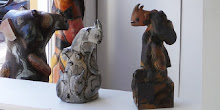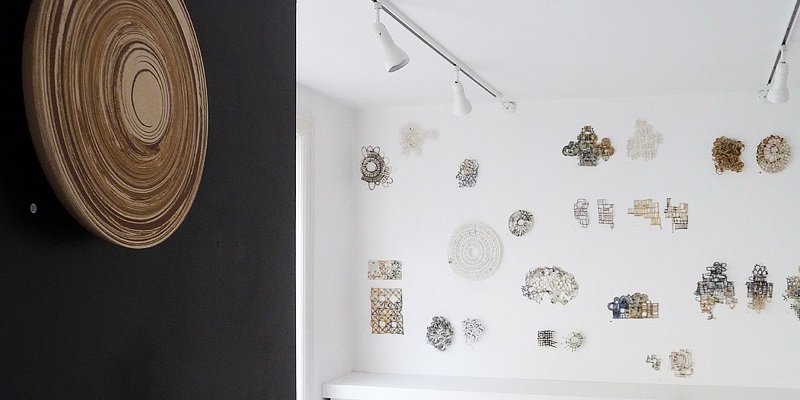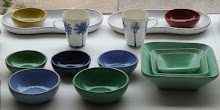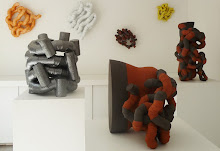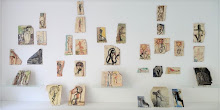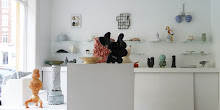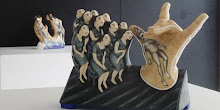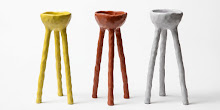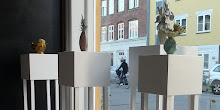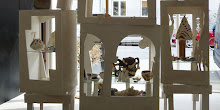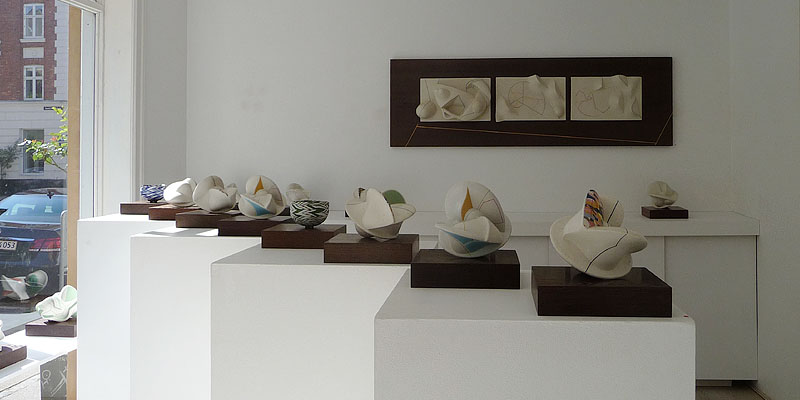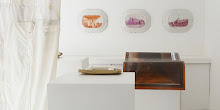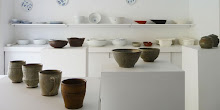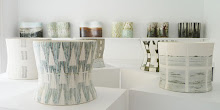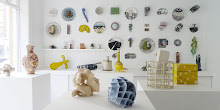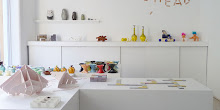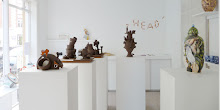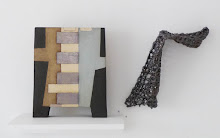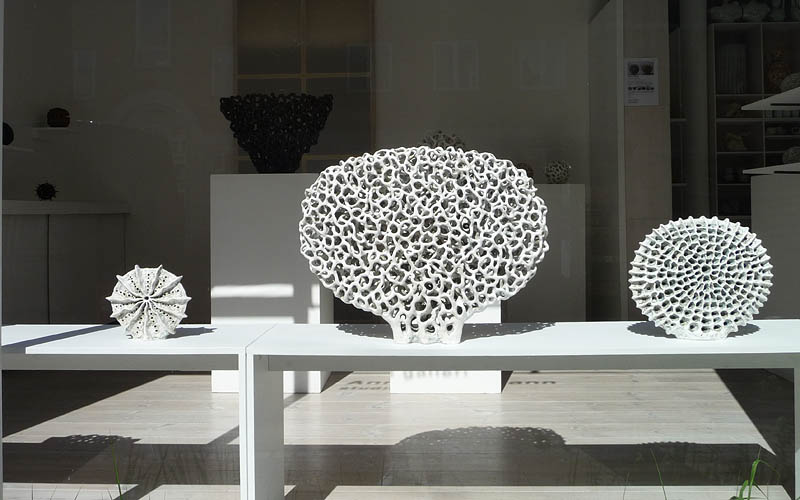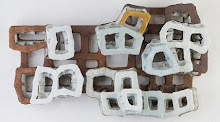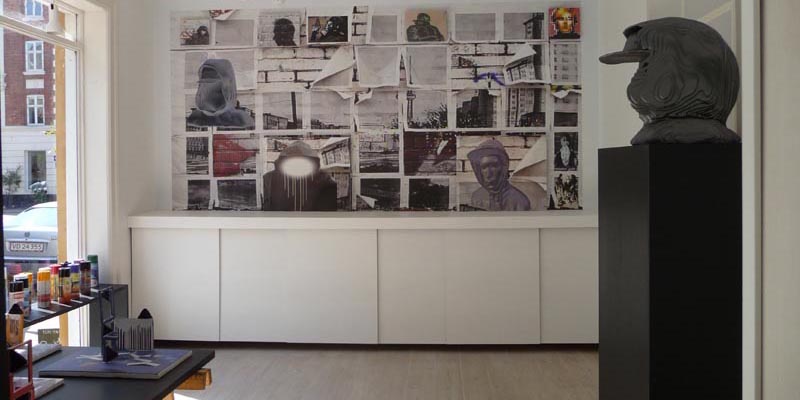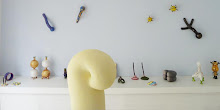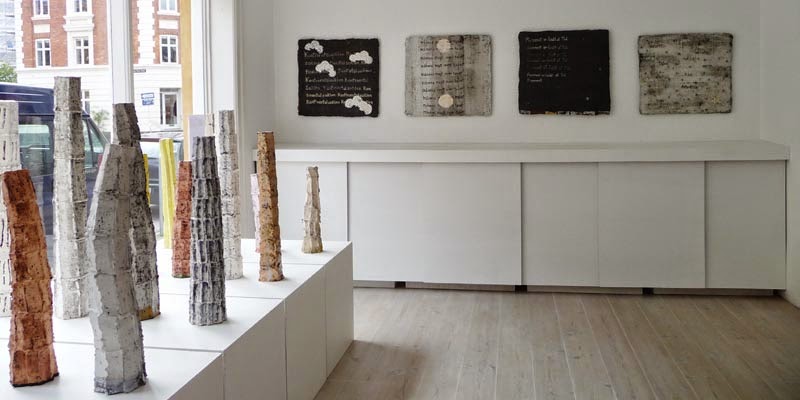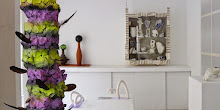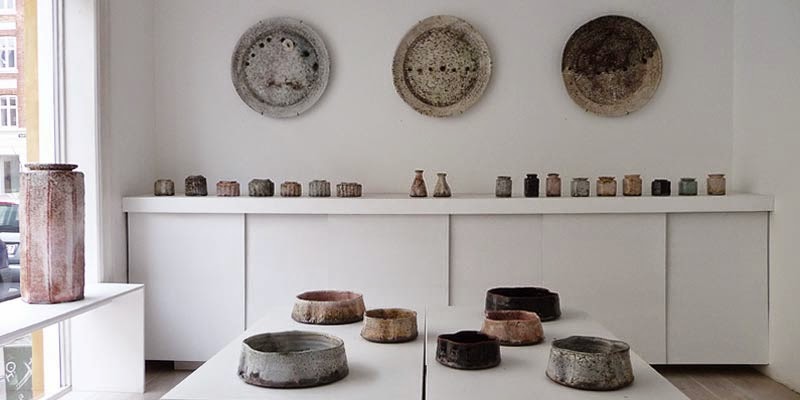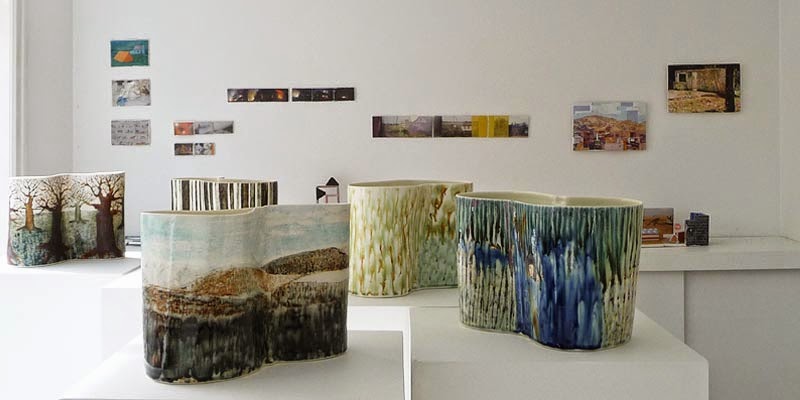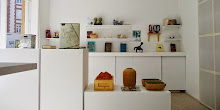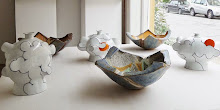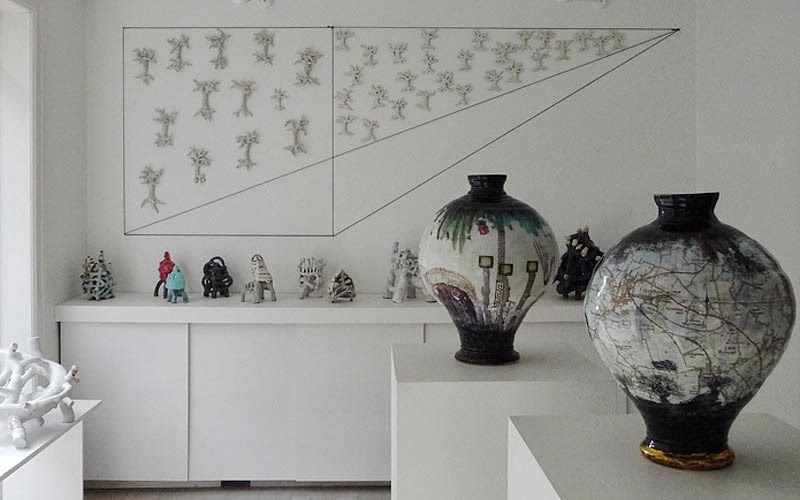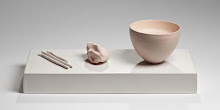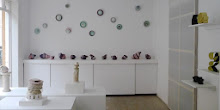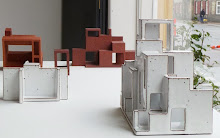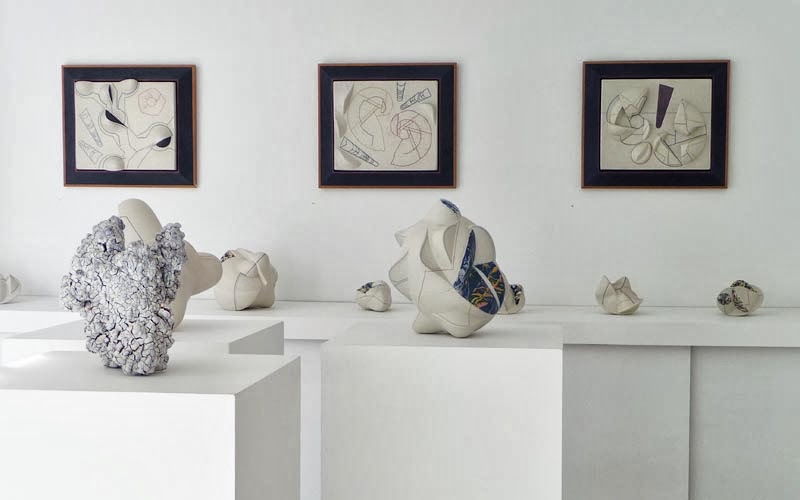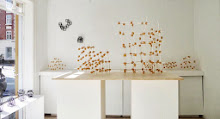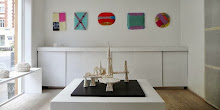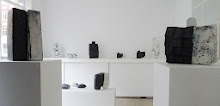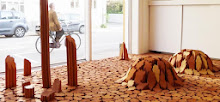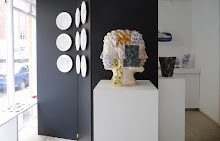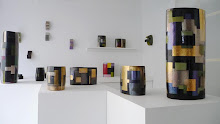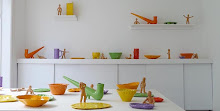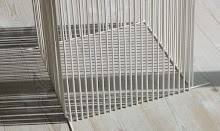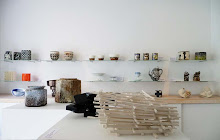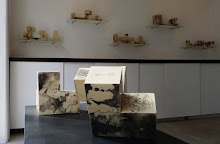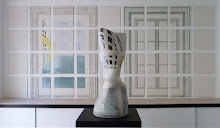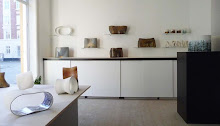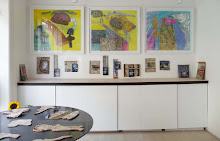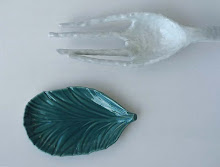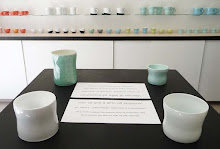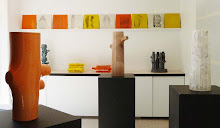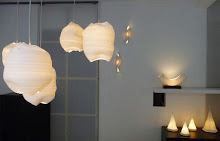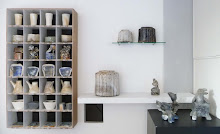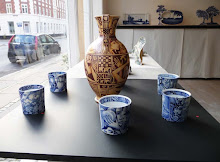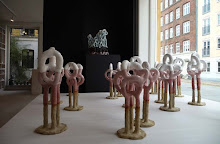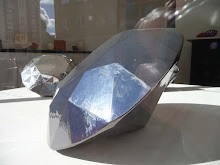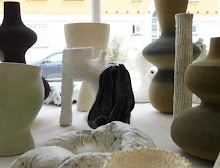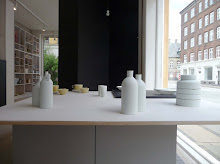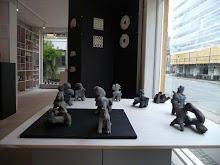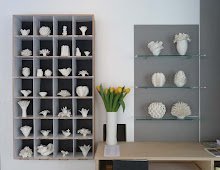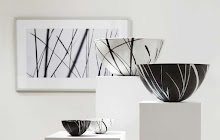skip to main |
skip to sidebar
 BAD BOYS
- and other stories
Terracotta by Peder Rasmussen
Exhibition 9 May – 8 June 2019
BAD BOYS
- and other stories
Terracotta by Peder Rasmussen
Exhibition 9 May – 8 June 2019
BAD BOYS - and other stories (... of which many ends well)
Peder Rasmussen delivers his message in a humorous way - and in ceramics
that gets everyone on to the story and the connection with the material.





He debates with his contemporaries in the image vessels Bad Boys, Happy Ending and Old Goat with references to both #MeToo, and personal experiences.


We are surrounded by countless technical accessories that have become such a large part of everyday life that it is difficult to imagine the simple and physical presence. In contrast, more and more people have discovered the ceramic material qualities and possibilities of contact with the earthy.
 Peder Rasmussen is not truly down to earth, but can almost be called visionary - if he is at all to retain!
Peder Rasmussen is not truly down to earth, but can almost be called visionary - if he is at all to retain!
But he speaks with both a presence and a relevance that causes us to listen... - or look for when it comes to his images on the ceramic vessels.
Curiously, we may move around his pieces to bring it all in.
Or simply rotate them, what the exhibition opens for.




For the exhibition he has looked at the Greek, Roman and Etruscan terracotta vases, painted in simple contrasting colours.




He writes about his new pieces: "..it would be interesting to see - in a world where all sorts of materials and techniques are available and used to a great extent - what one might even do if one were imposed such strict restrictions.




What if one only was allowed to use non-glazed clay and a single colour?
How are you artistically influenced by such limited possibilities?
When the choice consists of whether it should be a black figure on the clay background - or vice versa. A bit like using black/white rather than colour photos. A kind of 'dogma' for ceramists.. "
See the full text in the end of this page..

Peder Rasmussen is a potter, artist and one of Denmark's few great cultural personalities who takes the ceramic profession seriously. He gets involved in everything from writing critical submissions to as an author publishing ceramic-themed books.
For ceramists and other good people, he is an eternal debater and sometimes provocateur - but first and foremost one who can do his craft and play with all sorts of humorous angles, with a sharp tongue, a clear eye and look for historical themes that he rethinks and engages in with his works.
As a writer, Peder Rasmussen has enriched his readers with the art historical story "Family on a Wooden Leg. About J.F. Willumsen's Family Vase, 2016”.
He writes to his audience about the ceramics techniques and some would say "nerdy" analyses of glaze chemistry and material understanding, so that almost everyone can be involved, while giving a personal insight into the historical time that created this masterpiece.
Previous exhibitions at Ann Linnemann Gallery were 'SLEIGHT OF HAND' in 2016, when the works under the pseudonym Gert Pedersen were performed in close collaboration with Michael Geertsen, an exhibition that offered illusionist works.
 They took us on an adventurous journey where everything could happen... and happened. Animals and humans appeared from known and unknown worlds, tumbled around in a universe of jars and geometric shapes, where it was only kind of safe to enter and try on new achievements.
They took us on an adventurous journey where everything could happen... and happened. Animals and humans appeared from known and unknown worlds, tumbled around in a universe of jars and geometric shapes, where it was only kind of safe to enter and try on new achievements.
 IN THE WOODS in 2011, the figurines and dishes occurred in the winter (2010-11), where Peder Rasmussen worked with the Italian majolica technique, he first encountered when he in 1970 for a period settled in Faenza, the hometown of faïence.
IN THE WOODS in 2011, the figurines and dishes occurred in the winter (2010-11), where Peder Rasmussen worked with the Italian majolica technique, he first encountered when he in 1970 for a period settled in Faenza, the hometown of faïence.
Grateful thanks to The Danish Art Foundation for project funding in 2019.
TEXT BY PEDER RASMUSSEN
BAD BOYS - and other stories
(... of which many ends well)
Terracotta by Peder Rasmussen
TERRACOTTA
Some of the best ceramics I know are the Greek, Roman and Etruscan terracotta vases found at both the Danish Glyptotek and National Museum - and in numerous other collections.
Just simple materials: earthenware clay with black colour - that's it!
 I have long thought that it would be interesting to see - in a world where all sorts of materials and techniques are available and used to a great extent - what one might even do if one were imposed such strict restrictions.
I have long thought that it would be interesting to see - in a world where all sorts of materials and techniques are available and used to a great extent - what one might even do if one were imposed such strict restrictions.
What if one only was allowed to use non-glazed clay and a single colour?
How are one artistically influenced by such limited possibilities? When the choice consists of whether it should be a black figure on the clay background - or vice versa. A bit like using black/white rather than colour photos.
A kind of 'dogma' for ceramists.."
Would this fact itself generate new stories? Is it perhaps the case that the endless technical possibilities in reality may seem inhibitory to the narrative that pushes itself on?
They also require their place. In much contemporary ceramics, the material is almost the story itself. There I am not!
 In any case, I wanted to submit to these conditions and see what would happen.
In any case, I wanted to submit to these conditions and see what would happen.
I am a trained potter, so wheel throwing would actually be the natural way for me, especially when it comes to circular shapes.
But here too I have simplified: All forms are modelled.
The interesting thing is that where the relative high speed of the turning process is forced to relate to the profile, where you work, then the slowness of modelling allows you to relate more nuanced to the whole shape and a more varied textures.
My new vases are basically symmetrical, but modelling has made them slightly more vivid in shape - I hope then.
The circular jar is an ideal background for stories of almost cinematic character. This the ancient potters knew all about. Most of my new jars can therefore be considered as visual tape loops. The motif wraps around the form.
What you see right now creates expectation of something more. You become curious. Contrary to how it relates to painting, one can not see it all at once.
You have to move - or turn the vase. It is a dynamic imagery where the rhythm plays a crucial role - it runs the game.
 I have worked with elongated oval shapes as well.
I have worked with elongated oval shapes as well.
Here the image is divided into two sections.
The old ones achieved the same thing by using handles on the corpus. Nice for depicting here and there, before and after… etc.
When you do not have many colours to work with, you have to be inventive with what you have. Therefore, this technique starts an intensive use of variations between, for example, black line on red area, red line in black area.
You scratch, scrape and paint, but only one colour is allowed: black!
Ornaments will play the same role as graduations when working with multiple colours and glaze. The "empty" areas must also live, even if they are not directly in the story. In many ways, it is a bit like in early woodcuts - or in frescoes, which for some reason I have also got on the brain during this process.
 The vases divide into two main groups - the very direct narrative and then some more cryptic... also for myself.
The vases divide into two main groups - the very direct narrative and then some more cryptic... also for myself.
In the narrative vases, the story is often tied together by ornamentation. It has mostly to do with a sense of visual necessity. Maybe also with the "horror vacui" which I probably suffer from.
However, I praise myself that a single high vase is completely without decoration, that is pure form - just rhythm in the accumulation of its elements.
The "cryptic" often portrays people who are mustering around in an unmanageable and fragmented world. I have sought inspiration in the Renaissance and Baroque Grotesques, which is actually an ancient Roman artistic strategy.
THE CONTENT
The universe of the jar - to call the double-curved forms somewhat pretentious - is extremely suitable for characters floating weightless in their own world.
And my jars are full of characters - gentlemen, ladies, animals, objects and ornaments in more or less pretty interactions. I would be stretching the point too far, if I claimed that there is meaning to it all.
In fact, I have called one of the jars Stop Making Sense, a line from an old song by Talking Heads, that a few years ago was the theme of a whole line of image vases that just aren't included here.
 But some of the vases have a rather specific content.
But some of the vases have a rather specific content.
Not heroic as so often in ancient times, but more simultaneously - closer to anti-heroism.
Because while I have worked with the series, the #metoo campaign has ravaged the entire cultural landscape.
One has, in one's capacity as a man alone, had to see oneself acclaimed as almost untamable wildlife.
So my vase Bad Boys is a pure confession: yes, we are driving too fast - yes, we are looking for the girls, at least - yes, we eat and drink ... and smoke!
And we fart!
In short: Our unbearable act is unbearable, and the world would surely be a better place without us. But maybe just a little boring…?
 Another vase, Happy Ending, is that although the encounter between the sexes may occasionally begin a little awkwardly, perhaps most often, so is the chance that it may end well, present. Take it from a man who has been happily married for over forty years.
Another vase, Happy Ending, is that although the encounter between the sexes may occasionally begin a little awkwardly, perhaps most often, so is the chance that it may end well, present. Take it from a man who has been happily married for over forty years.
 A larger oval vase, Party shows a social occasion here in the house - at least a larger gathering.
A larger oval vase, Party shows a social occasion here in the house - at least a larger gathering.
I have always been attracted to depictions of many people in some form of dynamic interaction, but have never really been able to figure out how to do it on a vase.
I am a great admirer of Max Beckmann and R.B. Kitaj, who to a large extend had human trouble on the program - and this vase is inspired by both - and then Corbusier, who gave me the idea of putting in the big unifying ornamental figures over the plot.
 Old Goat is the story of, oh yes, the old 'goat', throwing himself into another round.
Old Goat is the story of, oh yes, the old 'goat', throwing himself into another round.
The circular shape of the jar is used as a background for a procession of tumbling figures.
No particular moral - or morality!
The last section of the exhibition consists of a few figures that were almost as a conclusion of the project. Several of the ornaments and details that otherwise appear on the vases have here moved out into free dressage.
Here, too, there is not much meaning to be found, but hopefully a nice drizzle of visual poetry, which is what everything is about.
BIOGRAPHY
PEDER RASMUSSEN was born in 1948. Ceramist and author. Educated at The Kähler Ceramics in Næstved 1966-70. Istitutto Statale per la Porcellana, Firenze, Italy 1970-71. Studio with ceramist Karen Bennicke since 1972.
Member of the exhibition groups MULTI MUD 1980-85 and END 2007-08.
Guest teacher at the Design School in Kolding 1983-99 and Denmark's Design School 1991-95.
Curator of several exhibitions eg. At the Design Museum Denmark, The Kähler Keramik, 2002 and J.F. Willumsen's Family Vase, 2016.
Author of the books: Kählers Værk, 2002. Reistrup, Udsmykninger & keramik (Commissions and Ceramics), 2006 and Family on a Wooden Leg. J.F. Willumsen's Family Vase, 2016.
Chairman of the Danish Art Foundation for Crafts and Design 2011-13.
GRANTS and AWARDS Kaj Bojesen's Mindelegat, C.L. David's Foundation, Ole Haslund's Artist Award and OJD-Foundation's Ceramics Award, and the Danish Art Foundation Lifelong Award.
MUSEUMS and COLLECTIONS Victoria & Albert Museum, London. Design Museum Denmark. Art Museum Trapholt & CLAY Ceramics Museum Danmark. National Museum, Stockholm & Röhss Museum of Decorative Art, Gothenburg, Sweden. National Museum & Nordenfjeldske Kunstindustrimuseum (National Museum of Decorative Art and Design), Trondheim, Norway. Keramion, Frechen, Museum für Kunst und Gewerbe, Hamburg & Hetjens Museum, Düsseldorf, Germany. Danish Art Foundation, Sweden & Denmark, Annie & Otto Detlef's Foundation, Denmark.
www.pederrasmussen.dk
FILM - part 1: www.youtube.com/watch?v=XXcNWV8kmaM&feature=related
FILM - part 2: www.youtube.com/watch?v=u17BfEl4f0U&feature=related
 SEEING THROUGH
Malene Müllertz
Exhibition 28 March – 4 May 2019
SEEING THROUGH
Malene Müllertz
Exhibition 28 March – 4 May 2019
To look through, to see it all - and look around the world. - A cultural story.
The gallery shows new works by the renowned Danish ceramist Malene Müllertz.





She is the epitome of Danish craftsmanship, unique ceramics of the highest quality, - finest handcrafted design.





The works contains a wealth of detail and finesse - only to be found in the best ceramics – where craft, material and technique are elevated to a higher realm. Work of this nature requires courage and persistence.





But this is not all that is to be said. In addition to the first immediate admiration of the works' aesthetic and technical qualities, there are many more layers and the telling of her familial narratives.
Malene Müllertz shows us her memories and her own family history.
As she discreetly says about the new pots titled, My Chinese Grandmother:
"Yes, it is quite true." (quote: H.C.Andersen)

The teapots have fine curved legs, look as though they are travelling to or from the eastern world
- and it is actually quite true that they are directly related to the Chinese language of form and symbolism.





"My Chinese great-grandmother fell in love with a Swedish captain - and their daughter moved to Denmark and married a Danish actor, theatre and film maker."
Her family was enriched by cultural diversity, a 'can do' and travel courage.
- See, this is a true adventure ...





Grandma was a dear and great inspiration - and in her works Malene Müllertz is influenced by the cultural details of things from Grandma's home and her own adult life, filled with journeys abroad, linked to an affection for her own contemporary cultural history, films, literature, materials and textile tactility.





 LEAF STEMS AND PORCELAIN LACE in the latest works come from the memory drawers, filled with textiles, baskets and lacquerware. Things that have been unconsciously seen and experienced from childhood - and throughout life.
LEAF STEMS AND PORCELAIN LACE in the latest works come from the memory drawers, filled with textiles, baskets and lacquerware. Things that have been unconsciously seen and experienced from childhood - and throughout life.
The world and other peoples are part of most of our histories. - Where do we come from and what are the cultural differences our families brought with them, what enriched us? These legacies are a natural part of our own personal memory.





Müllertz has learnt to gather her impressions into beautifully crafted art pieces that reveal the many references in a present and poetic manner.





Story continues and we all benefit from the multitude of impressions that unfolds in her works.
 The pieces can be seen through, seen from the inside and the outside at the same time and thus experienced as if in constant motion.
The pieces can be seen through, seen from the inside and the outside at the same time and thus experienced as if in constant motion.
The cylinder reveals its sculptural properties in a harmonious balance and at the same time contains tension-filled interactions between the form, the ornamental detail of the surface and the qualities of materials.
 Technically, every work is a marvel of carefully thought out experiments and the courage to attempt an idea that is revealed in the final piece.
Technically, every work is a marvel of carefully thought out experiments and the courage to attempt an idea that is revealed in the final piece.
Malene Müllertz has succeeded in creating apparently simple, yet complicated, technical, poetic, contemporaneous works of art with a cultural narrative that shall go down in history as eternal.
MALENE MÜLLERTZ (b. 1949) was educated from the Arts&Crafts School (Royal Academy of Crafts&Design) in Copenhagen 1965-70, Royal Art Academy, industrial design 1973-75. Artist at Bing & Grøndahl 1970-73, The Royal Copenhagen Porcelain 1977,82, own workshop since 1975. EXHIBITIONS in Denmark and internationally. Ceramic Ways: CLAY Ceramics Museum Denmark 2018, Anniversary Exhibition, Sophienholm 2015. Ann Linnemann Gallery Fragile 2012. Design Museum Denmark and Gallery Nørby 2007. Puls Contemporary Ceramics, Belgium. Collect, V&A Museum, London. MEMBER of the Artist Society and Ceramic Ways. Receives the Danish Arts Foundation's Lifetime Award.
www.malenemullertz.dk
Grateful thanks to The Danish Art Foundation for project funding in 2019.
TEXT & NOTES by Malene Müllertz
 In my new NET VESSELS, the FISHING FYKES -
In my new NET VESSELS, the FISHING FYKES -
I go back to the humans first tools
- The braided basket.
It's a kind of dual shape, built up over several days, of soft extruded clay threads, without the use of a template and tool, just my eyes to check the shape is continuous.
The impression of the many dark threads running simultaneously and gathering, and finally creating the whole shape.
The geometric structure of 'threads' cocoons itself and expresses something eternally valid. - As the wasp builds its nest, round and round.
 MY CERAMIC FYKES I see as when I see Willumsen's 'Village with a view of the mountains' in Málaga.
MY CERAMIC FYKES I see as when I see Willumsen's 'Village with a view of the mountains' in Málaga.
I would like to depict
what it is to look out into the world
- high up from the mountain.
I do my things so that we can (re)visit our life out in the world.
We have our two feet planted on the earth and only this one – it is a way to recognize our existence in simple but harmonious forms and structures.
Remembrance - Vulnerability.
Maybe my work resembles something we've encountered before - not concrete.
But in our memory there is something from eternity.
Maybe it's just the natural order we recognize.
 For me it is important that my vessels/ structures are focused on themselves
For me it is important that my vessels/ structures are focused on themselves
- as one's own life cycle from here to there, a world resting in itself
- but also in the hope proactive in its substance,
a forceful symbol of our life, a reminder of our existence.
II know when it is right.
A sort of order where the boundaries are important for what a pot can 'accommodate'.
I'm still loyal to the original 'pot/ vessel'. Imprint the wet clay.
Finger taps. Sensitive feeling.
Concerned about describing vulnerability. And tenderness.
Moving on a knife edge.
I make them as a counterweight - and defence against the world's horror and misery - would not be able to be here to express vulnerability, if I am not allowed to make them.
HOW FAR CAN IT GO
What I love, and which to me is the whole inspiration and incentive, is where I work within a kind of framework
- and where I cautiously make myself clear, how far the clay can be moved.
The moment I open my kiln to see the final result - and see that my experiments have been successful, I see that my effort have been rewarded.
Craftsmanship is a fierce and demanding search within the physical boundaries of the materials and what they can do.
It gives us reminders of the fragility of life, our responsibility for nature – and, in all probability, as a kind of shield against all the world's troubles.
 NATURE and BAROK - New net pots in stoneware and porcelain
NATURE and BAROK - New net pots in stoneware and porcelain
The dark coarse clay is combined with chalk white porcelain - a technical and visual balancing act.
Here I have examined crafts such as embroidery, wickerwork, knitwear and textile (weaving) that can also move into 'another dimension'.
LEAF STEMS in the stoneware cylinder - and THE CROWN FLOWER in porcelain, combine the dark form with a dancing light and rhythmic top border.
The contrast between the dark earthly leaves - and the wind, clouds, dance and the lights of transparency.
- Still following the classic rules of a jar, that is formed in a circular movement.



MY CHINESE GRANDMOTHER - pots
At the same time as the nature-inspired vessels, which are still a great ballast and necessary part of my everyday life,
- I continue my paraphrase of the tea pot.
This time with pots that I call:
My Chinese Grandmother - (yes, it is quite true)
They look as if they will roll away, says Ursula Munch Petersen.
Small adventures, like looking out into the world high up, to spot sizes, a freedom to see, spatiality and..
I don't know where it comes from. - It presses itself on, and I 'hasten' to grab a pad and pencil - still tentatively draw a thin line that forms the idea.
 SOUND BELL BASKET - stoneware
SOUND BELL BASKET - stoneware
Dark grey-spotted ceramic cylinder jar form, made as a net and attached with loose fragments.
The loose moving parts provide a vibrant and cheerful feeling when you take the net in your hands - beside providing a tinkling sound, like a thousand bells when it is moved.
The Marguerite flower has been my starting point in my sound basket, and the bright sticks that tilt back and forth equal the flower's stamens.
Visually and physically changeable as nature.
They are made on throwing-wheel, inserted a slab base, cut and brushed.
The tilt pins are modelled separately and mounted with small balls of light clay, carefully aligned with regard to the mobility.
Partially glazed after bisque-firing with a matt quartz-syenite stoneware glaze, and with a purpose-made cloth tool - to avoid melting of the loose parts during firing. Electric kiln at 1270C.
BIOGRAPHY - CV
MALENE MÜLLERTZ
Born in 1949
EDUCATION & EXPERIENCE
1965-66 Ceramic workshop /internship
1965-70 Arts&Crafts School
1970-73 Employed as Artist at Bing & Grøndahl Porcelain Factory
1973-75 The Royal Danish Academy of Fine Arts, School of Architecture, industriel design
1977,82 Employed as Artist at the Royal Copenhagen Porcelain Factory
1975 Own ceramic studio
PUBLIC COLLECTIONS
Augustinus Fonden. Carlsberg Academy. CLAY Museum Denmark. Design Museum Denmark. Ellen & Knud Dalhoff Larsens Fond. Culture Ministry. Ny Carlsbergfondet. Danish Ar Foundation. Trapholt Museum, Kolding. The Danish Embassy, Berlin. Keramion, Frechen, Köln. Museum Het Princessehof, Leeuwarden. Museum Boymans van Beuningen, Rotterdam. National Museum, Stockholm. Nordenfjeldske Art Museum, Norge. Schleswig-Holsteinisches Landesmuseum, Schloss Gottorp. Sammlung Thiermann, Hamburg. Palmer Museum of Art, Pennsylvania State University, USA. Victoria & Albert Museum, London.
GRANTS AND AWARDS
Tecnical Society Awards: Bronze 1970, Silver 1982
Danmarks Nationalbank's Anniversary Award, 1975,82,89,92,94,95,97,98,04,06
Danish Art Foundation stipend, 1985,91,93,95,97,99,01,03,05
Artist-in-residence San Cataldo, Italy, 1985
Johs. Krøyer's Award, 1985
Ole Haslund's Artist Award, 1986
Danish Art Foundation 3-year Stipend, 1988-91
Tuborg Award, 1992
Politiken's Award, 1992
Artist-in-residence Spain, Fondación Valparaiso, 1993
Artist of the Year, JyllandsPosten, 1995
Residency Award, Paris, Ludvig Preetzmann-Aggerholms Fond, 1995
C.L. Davids Legat for slægt og venner, 1997, 98 02 og 06
L.F Foghts Award, 1997
Lis Ahlman's Award, 2002
Solar Fonden, 2003
Beckett Fonden 2003,06
Residency Award, Berlin, Jyllands-Posten, 2004
Oticon Award, 2004, 06
Kong Christian X's Award, 2004
Augustinusfonden, 2006
Inga & Ejvind Kold Christensen Award, 2007
SELECTED SOLO EXHIBITIONS
Design Museum Denmark, Copenhagen, 1983
Galerie Heidi Schneider, Zurich, 1983
Galerie L, Hamburg, 1984
Blås & Knåda, Stockholm, 1985
Galleri K, Copenhagen, 1985
Vestsjælland Art Museum, Sorø, 1988
CLAY Museum Denmark, 1995
Designmuseum Danmark, 'New Ceramic Boxes', 1997
Næstved Museum, Boderne, 'Najade Dreams', 1997
Galleri Björnen, Stockholm, 1999
Galleri Granberger, Sweden, 1998
Galleri Nørby, 'New Ceramic Works', 2000
Galleri Nørby, 'Network', 2002
Puls Contemporary Ceramics' Brussels, 2003
Design Museum Denmark, 'New Ceramic Works', 2007
Galleri Nørby, Copenhagen, 2007
Sophienholm, 'Ceramic Ways ', 2009
Ann Linnemann Gallery 'Fragile', 2012
Kaolin, Stockholm, 2012
Sophienholm, Anniversary 'Ceramic Ways', 2015.
CLAY Museum Denmark, 'Ceramic Ways', 2018
SELECTED EXHIBITIONS
Charlottenborg, Spring Exhibition, 1970,77,84
Viborg Stiftsmuseum, 1975
Design Museum Denmark, 1976,77,80,82,85,96,03,05
Royal Copenhagen Porcelain, Copenhagen, 1977
Galleri Sluis, Leidschendam, 'Boxes', 1981,85
Palmer Museum of Art, Pennsylvania State University, USA, 1981
Museum für Kunst und Geerbe, Hamburg, 1981
Herbert F. Johnson Museum of Art, Ithaca, NY, USA, 1982
Wilhelm Hagg Museum, Ludigshafen, 1984
Oldenburg Stadtmuseum, Germany, 1984
Fyn's Art Museum, 1984
Den Frie, 'Keramiske Veje', 1985,87,89,92,94,97,00,04
Esbjerg Kunstforenings Samling (w. Vibeke Klint), 1988
Victoria & Albert Museum, London, 'Scandinavian Ceramics & Glass in the Twentieth Century', 1989
Singer Museum, Laren, Holland, 1990
Viborg Kunstmuseum (w Vibeke Klint), 1990
Kunstindustrimuseet, Helsinki, 'Art and Industry in Ceramics', 1992
'Keramik Europas', Keramikmuseum Westerwald, Höhr-Grenzhausen, Germany, 1993
'Keramik Europas', Museum Het Princessehof, Leeuwarden, 1994
Bornholms Museum, Gudhjem, 1994
Art Museum Trapholt,'Danske Keramiktriennale', Kolding, 1994
Galleri Lejonet, Stockholm, 1995
City Art Centre, 'From the Golden Age to the Present Day', Edinburgh, 1995
Museum Boymans-van Beuningen, 'Danish Ceramics', Rotterdam, 1995
Galerie Besson, 'Danish Pots and their Influence', London, 1995
Sophienholm, ' Danish Ceramics 1850-1997', Lyngby, 1997
Haderslev Museum, 'Danish Ceramics', 1998
Sigtuna Museum, 'Danish Ceramics', Stockholm, 2001
Galleri Yofuko, 'Euro Art/Clay', Tokyo, 2001
Nordjylland Art Museum, 'Flet', 2001
Borreby Castle Gallery, 2001
'From the Kilns of Denmark', travel exhibition, USA/EU/ American Craft Museum, NY, 2002
Danish Embassy, Berlin, 2004
Gallery Carlin & Maison Danemark, Paris, 2004
De tiendschuur Tegelen Museum, 'Danish Ceramics', Holland, 2005
Designmuseum Danmark, 'Kunstforeningen af 14. August', 2005
COLLECT ART FAIR, Victoria & Albert Museum, London, 2005,06,07
SOFA ART FAIR, New York 2008,09,10,11
Ann Linnemann Gallery 'Master Pieces', 2018
MEMBER OF
Kunstnersamfundet and 'Ceramic Ways'
Danish Art Foundation, Lifelong Artist Award, 2007








 Peder Rasmussen is not truly down to earth, but can almost be called visionary - if he is at all to retain!
Peder Rasmussen is not truly down to earth, but can almost be called visionary - if he is at all to retain!












 They took us on an adventurous journey where everything could happen... and happened. Animals and humans appeared from known and unknown worlds, tumbled around in a universe of jars and geometric shapes, where it was only kind of safe to enter and try on new achievements.
They took us on an adventurous journey where everything could happen... and happened. Animals and humans appeared from known and unknown worlds, tumbled around in a universe of jars and geometric shapes, where it was only kind of safe to enter and try on new achievements. IN THE WOODS in 2011, the figurines and dishes occurred in the winter (2010-11), where Peder Rasmussen worked with the Italian majolica technique, he first encountered when he in 1970 for a period settled in Faenza, the hometown of faïence.
IN THE WOODS in 2011, the figurines and dishes occurred in the winter (2010-11), where Peder Rasmussen worked with the Italian majolica technique, he first encountered when he in 1970 for a period settled in Faenza, the hometown of faïence. I have long thought that it would be interesting to see - in a world where all sorts of materials and techniques are available and used to a great extent - what one might even do if one were imposed such strict restrictions.
I have long thought that it would be interesting to see - in a world where all sorts of materials and techniques are available and used to a great extent - what one might even do if one were imposed such strict restrictions. In any case, I wanted to submit to these conditions and see what would happen.
In any case, I wanted to submit to these conditions and see what would happen. I have worked with elongated oval shapes as well.
I have worked with elongated oval shapes as well.  The vases divide into two main groups - the very direct narrative and then some more cryptic... also for myself.
The vases divide into two main groups - the very direct narrative and then some more cryptic... also for myself. But some of the vases have a rather specific content.
But some of the vases have a rather specific content.  Another vase, Happy Ending, is that although the encounter between the sexes may occasionally begin a little awkwardly, perhaps most often, so is the chance that it may end well, present. Take it from a man who has been happily married for over forty years.
Another vase, Happy Ending, is that although the encounter between the sexes may occasionally begin a little awkwardly, perhaps most often, so is the chance that it may end well, present. Take it from a man who has been happily married for over forty years. A larger oval vase, Party shows a social occasion here in the house - at least a larger gathering.
A larger oval vase, Party shows a social occasion here in the house - at least a larger gathering.  Old Goat is the story of, oh yes, the old 'goat', throwing himself into another round.
Old Goat is the story of, oh yes, the old 'goat', throwing himself into another round.





















































